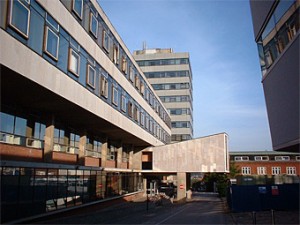In industrialised countries building refurbishment is generally considered to be vital in order to achieve major carbon emission reductions in the built environment. At high latitudes the largest single consumer of energy in buildings continues to be space heating required for creating comfortable indoor conditions. For example, a typical 3 bedroom UK house has, on average, an annual heating demand of about 20,000 kWh. This is where a real step change in energy performance can be made. Therefore, refurbishment creating well sealed buildings with low energy losses through the building fabric is encouraged by current building legislation in the Europe and the UK.
Various studies have shown that it is possible to obtain buildings that have a near zero heating demand, even in the residential sector where internal heat gains can be expected to be lower than inside densely occupied office buildings. However, such flagship projects are in general new built structures.
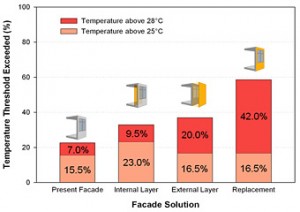
Fig. 2 – Refurbishment options for a 1960’s office building (in the foreground of Figure 1): occupied time of the case study office in which the room temperature exceeds 25°C / 28°C.
In the UK many buildings, whether residential, commercial or industrial, are still single glazed and possess no or poor thermal insulation (Figure 1). However, as the work of the Sustainable Energy Research Grouphas revealed, care needs to be taken when adding thermal insulation to existing buildings without addressing solar shading and ventilation issues at the same time. Adding thermal insulation and exchanging windows primarily optimises winter performance of the building. However, in commercial buildings in particular, which have high internal loads summer performance may be compromised.
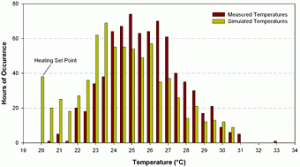
Fig. 3 – Case study office temperature: distribution of measured temperatures (brown) over a one month period (15/08 to 14/09/2005) / simulated temperatures (green) for the same month (weeks 33 to 36).
Simulation studies of a cellular office space inside the 1960’s building shown in the foreground of Figure 1 have indicated that a refurbishment of a leaky façade without provision of any additional ventilation scheme increases summer overheating risks and compromises indoor comfort for the occupants (Figure 2). As can be seen in Figure 3, the distribution of measured and simulated temperatures over a one month period match well for summer 2005 data if compared to simulation results using a hot summer year weather file. However, as 2005 was an exceptionally warm year, the measured temperatures exceeded the simulated ones by about 1 °C. In consequence the refurbishment solutions depicted in Figure 2 can be expected to perform worse in terms of hot office room temperatures under a 2005 climate. The trends of these simulation findings have been confirmed in observations comparing naturally ventilated buildings with leaky façades to those with air-tight façades.
The group consults the University’s ‘Estates and Facilities’ department in refurbishment projects across the University, in order to achieve energy efficient buildings that do not compromise user comfort.
Work has been published in:
Jentsch M.F., James P.A.B. and Bahaj A.S. (2006) Secondary façade layers for building refurbishment and their potential impact on building performance. Proceedings World Renewable Energy Congress (WREC-IX), Florence, 19-25 August 2006.
Kaluarachchi Y., Jones K., James P.A.B., Jentsch M.F., Bahaj A.S., Clements-Croome D.J. and Gann D.M. (2005) Building facades: sustainability, maintenance and refurbishment. Proceedings of ICE, Engineering Sustainability, Volume 158, Issue ES2, June 2005, pp 89-95. View paper.
B-space (Building Specific Pre-refurbishment Assessment of Comfort and Energy)
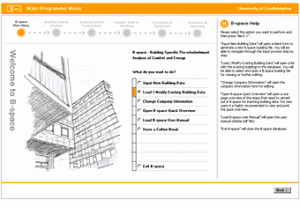
Fig. 4 – Welcome screen of the database driven B-space tool showing the general design structure of the tool. A comprehensive input guidance is given on the right hand side of the screen.
Within the framework of the IDCOP research project a pre-refurbishment tool for assessing buildings is currently being developed (Figure 4). This tool which is termed B-space assesses the energy demand of multi-storey office buildings taking into account occupier comfort. B-space is targeted at asset mangers as main user group. It enables calculation of a building’s carbon footprint and gives an energy performance rating relative to a building asset portfolio (Figure 5).
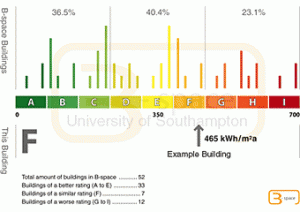
Fig. 5 – Energy rating scheme proposed within B-space to give an indication of a building’s energy performance within an asset portfolio.
B-space is designed similar in structure to online booking processes, i.e. the data input follows a step by step procedure with intermediate data validation. B-space has five major steps for data input which are subdivided into smaller sub-steps. The steps build up on each other, starting with more general building information and then proceeding with construction, façade and occupancy parameters. In the last step the inputs are summarised and a printable energy performance report is displayed for the evaluated building.
The complexity of inputs is kept at a level that allows ‘non-experts’ to assess a building in its energy and comfort performance without extensive training. It is anticipated that a full B-space assessment will take no longer than half an hour.
Aspects of this work have been published in:
James P.A.B., Jentsch M.F. and Bahaj A.S. (2006) B-space: pre-refurbishment assessment and classification of building façades.Proceedings 2nd International Conference of Renewable Energy in Maritime Island Climates (REMIC 2) – Dublin, 26th – 28th April 2006, pp 221-227.
